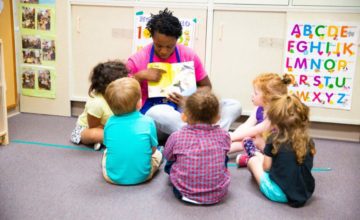When your toddler takes that first step, the world as you (and your child) know it, changes forever! Browse the information and links below to see what your little one is experiencing and learning this month.
IN THIS RESOURCE
- What It’s Like for You
- What It’s Like for Baby
- What to Expect From Your Baby’s Development
- Did You Know…
- Spotlight on: Helping Your Toddler Cope With Change
- Let’s Play: Activities That Nurture Bonding and Learning
- What’s on Your Mind?
- Expert Reviewers
What It’s Like for You
When your toddler takes that first step, the world as you (and your child) know it, changes forever. One major benefit is that your child’s ability to walk provides you with lots of new and important information about what she is thinking. She shows you what she’s interested in—because she walks toward it. You know what she wants no part of—because she walks away. You see what she’s curious about by following her path around the house or at the park. She may stop at a puddle, run toward a squirrel, walk around a tree trunk, or stop to touch a flower. So as you follow the zig-zag path that your little explorer is walking, don’t forget to take a few minutes to wonder at your child’s discoveries: The color, the feel, the smell of every single thing around her, and the wide-open possibility for exploring the world…now that she can walk.
What It’s Like for Baby
What a day! So much to see and smell, hear and do. The wind feels so cool on my face and I love the smell of the grass. Wait—I hear a dog barking. I look around, shout, Dog!, and point at the dog. Abuela says, Yes, that’s Sampson. He’s saying hello. Then she points up into the sky: Look! Look up there! Do you see the cardinal? That’s the red bird up in the sky. I love talking with Mi Abuela. She always tells me about what I’m seeing and hearing on our walks. And she listens to what I have to say, too.
But…sitting in this stroller is getting a little boring. Maybe if I wiggle around a lot and make some unhappy noises, Abuela will unstrap me and let me get out. I try it, and she says, I know, I know. You want out. Luckily, we’re here! We’re at the library. Let’s go. She stands close behind me while I climb the steps of the library. I push her away to show her I can do it on my own. She says, I know you can do it, but I want to stay close by just in case. When we get inside, I go straight to the children’s section. Then she lets me pick a book to read while we cuddle up on the couch. I love my Abuela.
What Your Baby Is Learning
Social-Emotional Skills:
- Confidence, that he can do things like climb stairs, find the children’s section of the library, and choose a book
- How to build a loving relationship with important adults, like his Abuela
- How to communicate his feelings, like curiosity, boredom, and excitement
Language and Thinking Skills:
- Using his own words (dog, me) and gestures (pulling at the straps of his stroller, pointing) to communicate
- New words, like cardinal
- Understanding his Abuela’s words
- Connecting the sound of barking with the word for dog
- Using his past experience in the library to help him find his way to the children’s section
Physical Skills:
- Practicing climbing steps two feet at a time
- Walking confidently
What to Expect From Your Baby’s Development
As you review the chart, keep in mind that development is not a race and that every child grows at her own pace and in her own way. Your child may develop skills faster or slower than indicated below and still be on track. If you have questions or concerns, talk with your child’s health care provider or other trusted professional.
Your Toddler’s Development From 12 to 15 Months
| What Your Baby Can Do | What You Can Do to Connect With Your Baby |
|---|---|
I’m moving! |
|
|
|
I’m starting to talk and understand so much more. |
|
|
|
I want to do more for myself. |
|
|
|
I love to imitate. |
|
|
|
Did You Know…
That when your 14-month-old imitates you, you are helping her become an ethical person? In a research study, mothers demonstrated a simple movement and asked their 14-month-olds to copy them. Researchers visited the children again when they were 33 and 45 months old, this time to test their ability to distinguish right from wrong. Researchers asked the children to play games that were impossible to win by following the rules (to see if children would follow the rules anyway). The children who had eagerly imitated their mothers at 14 months were also most likely to stick to the rules of the game at 33 and 45 months old.
What the Research Means for You
Young toddlers are very aware of and influenced by the grown-ups they know and trust, especially their moms and dads. They want to be like you and do what you’re doing. That’s why they’re so interested in holding your cell phone, shaking your car keys, walking around with your briefcase, and even trying on your shoes. So what is the link between imitation and the development of a conscience? Babies and toddlers who imitate the adults they love are also likely, as they grow, to adopt their families’ behavior, values, and ethics. Imitation also reflects a toddler’s interest in and attention to a loved adult’s behavior. This leads (as children grow) to an interest in the adult’s values and expectations—which supports the development of their conscience.
Children are imitating all the time during everyday play and interactions. You can also make imitation part of your daily routines. As you are making dinner, give your toddler a spoon so that he can stir, too. If you are sweeping, offer your child a dust broom. While you’re making your bed, ask your little one to pull the blanket up or put the pillow into its place. Imitation is a great way for your child to learn new skills and to discover, at the same time, how good it feels to be helpful.
Spotlight on: Helping Your Toddler Cope With Change
There are all kinds of changes—both big and little—in a toddler’s life. Some changes happen on a daily basis, such as transitions from one activity to another, or from playtime to lunch-time to nap time. Other changes are a bigger deal, such as switching from bottle to cup, getting rid of the pacifier, moving from a crib to a “big kid” bed. Still other changes—life-changing ones—may happen only once in a long while. These include starting a preschool or child care program, moving to a new home, welcoming a sibling, or coping with a separation from or loss of a loved one.
Changes can evoke a range of feelings in children, including:
- Excitement
- Sadness
- Fear
- Anger
- Happiness
- Confusion
- Anxiety or worry
How children cope with change is strongly influenced by their temperament—their individual approach to the world. For example, some children are, by nature, more reactive to changes. Other children go-with-the-flow, managing changes with ease. As you read about these differences in temperament below, think about how your child reacts to change and how you can help him or her cope.
1. Keep-It-the-Same Kids
These children have a harder time with change. They tend to:
- React to even the smallest of shifts—a new nipple on the bottle, a new food on their plate, or a slight change in a regular routine;
- Thrive on predictable routines to feel safe and secure;
- Need time and support to get comfortable in new surroundings or with new people; and
- Have more tantrums, which can be triggered by either minor changes (a new pair of shoes) or more major ones (a new babysitter). Tantrums can also unfold during everyday transitions, for example when children are asked to stop doing something they are happily involved in to begin another activity (such as going from playtime to lunch).
2. Roll-With-It Kids
Other children seem to take change in stride. They tend to:
- Find changes easier to cope with. New jackets, new friends, new foods, and new babysitters are interesting, not scary.
- Adapt to new people and experiences fairly quickly and easily. These are the babies who can nap in noisy restaurants, nurse wherever you happen to be, and (when older) are eager to explore a new playground or play with a new friend.
Your Child’s Response to Change
Most children fall somewhere in the middle of the two ends of the spectrum described above. They may have an easy time with new foods, but a more difficult time with new places. They may be cautious around unknown adults, but perfectly comfortable with new peers. Given some time to get used to a change or new situation, they feel safe, at ease, and eager to explore. Take some time to think about your own child. When your toddler has faced changes in the past—big or small—how has he reacted? What do you think he finds challenging and why? What helps him adapt if he is having a hard time?
Helping Your Child Cope With Change
1. Strategies for Keep-It-the-Same Kids
- Use familiar objects to ease anxiety during transitions. A new doctor will be less scary if your child has her favorite blanket or stuffed animal in hand.
- Let your child be part of the transition. Let him put the ball in the stroller bag when it is time to head home from the park or press the button to turn off the TV.
- Ease into new activities. Talk about new activities first and arrive early enough to allow your child to get comfortable.
- Offer advance notice when an activity is about to end: When this book is finished, we’re going home.
- Notice and comment when your child has successfully made a transition. You got into the car seat so quickly. That means we’ll have more time to play when we get home.
- Give your child a sense of control about how he wants to make transitions. For a toddler, you might say, Would you like to kick the ball one more time before we leave? Or, It is time to stop playing and eat dinner. Do you want the red plate or yellow plate?
- Use humor. Turn your child’s toothbrush into a puppet who says, Knock, knock. It’s Mr. Toothbrush. He wants to come inside your Mouth House to clean your teeth! Or, take your own toothbrush and start brushing your cheek. Your child will probably start laughing and show you how you really use a toothbrush.
2. Strategies for Roll-With-It Kids
- Offer your child a variety of new experiences. Try a new park, check out the local pool for water play, or visit the library for story hour.
- Be sensitive to your child’s signals. When a child is very easygoing, we can sometimes take for granted that any change is okay. Your child might have an easy time with new people, but still have a tough time saying good-bye to you at her babysitter’s house.
- Let your child know about new situations ahead of time. For example, tell him before going to a new place or meeting someone new. Children who enjoy new situations also enjoy talking about and looking forward to them. You can also give your child some control over the change, for example, by letting him choose what to wear on his first day of preschool or letting him pick out the blanket for his new bed.
- Be sure to find some one-on-one quiet time to enjoy together. No matter how much a child enjoys being out in the world, there’s nothing like snuggling at home with her favorite person.
- Be sure to keep some things the same. During times of change, it’s important to keep your child’s important daily routines consistent (like your child’s bedtime routine). This “same-ness” helps your child feel safe and secure, and gives him the strong foundation to continue coping with new changes so well.
3. Strategies for All Kids:
- Talk and read about changes. If you are moving or expecting a baby, share stories about these changes. Talk with your child about what will, and will not, be changing.
- Create a ritual for big changes. For example, if a friend is moving away, you can have a “good-bye” ice cream party for him. Or, if you are switching caregivers, you can create a photo book so your child can remember the important role this person played in her life.
- Keep your family traditions going. Do you have pancakes every Saturday? Well, keep the flapjacks coming even—and especially—when there is a lot of change in your child’s life. Family traditions make children feel loved and grounded.
- Show your child how you cope with change. Your child is watching and learning from everything you do. As you cope with change, get in the habit of talking about how you are feeling and what you are doing to cope: I feel sad to be moving to a new house. Even though it will be great and our family will be happy there, it feels sad to say good-bye to our old house. Why don’t we take a picture by the front door so we can remember it? While your child doesn’t understand your words now, he will soon. Your problem-solving techniques will provide a great model for managing change and the stress that sometimes accompanies it.
Let’s Play: Activities That Nurture Bonding and Learning
Let’s Play Pretend
Children this age are in the early stages of understanding pretend—a critical step in their intellectual development. You can encourage your child’s ability to pretend by doing things like feeding her favorite stuffed hippo with a spoon, putting it in the stroller for walk, or snapping a bib around its neck. Water-proof dolls can go in the tub for a scrub. Give your child a turn to help you take care of her hippo (or bear or doll). Talking as you play also helps your child develop language and social skills.
Watch Out, Dump Truck Is Coming!
If your toddler is now walking, it’s time to “drive.” Get a doll stroller, laundry basket, or sturdy cardboard box (about the size of a moving box) and open up the top. Let your toddler load up the “dump truck” with soft balls or stuffed animals and then push it around the house. The two of you can have some fun dumping out the “load.” (Be sure to say beep beep beep as you back up!) This game is also a way of making clean up fun as you can go around the house picking up toys and putting them in the “truck” and returning them to their proper places.
What’s on Your Mind?
1. My 14-month-old is scared of the vacuum cleaner. Whenever I try to clean he starts to cry. I don’t know what to do?
The vacuum cleaner, from a toddler’s perspective, can look and sound pretty darn scary. So the challenge is to figure out why your child is so distressed by it. The following are some possible explanations:
- Children take in and respond to sensations like touch, sounds, and sights in different ways. For example, when faced with a fire truck racing by, some children delight in the very stimulating lights and sounds, some are totally overwhelmed and start to cry, and yet others seem to completely ignore it. Your child may scream when he hears the vacuum because it is producing more stimulation than he can handle. The sound of the vacuum may actually feel painful to him.
- Seeing the vacuum suck things up and make them disappear can be scary to a toddler.
- Children who are generally more fearful and cautious by nature are more likely to find an object like the vacuum cleaner scary.
How you handle this depends on why you think the vacuum is causing your son’s distress. If you find that your son is sensitive to noises in his environment (i.e., prefers softer music, gets distressed in noisy places like the mall or grocery store), then first, protect him from this distressing sound. Vacuum when your son is not in the house or is in another room with someone who can distract him. However, as your son grows and moves out into the world, he will inevitably encounter lots of loud noises. To help him learn to handle loud noises like these, introduce him slowly to new and different sounds but stop when he begins to show distress. Over time you will help his system handle the sounds that are now overwhelming him.
If you think that the vacuum is a scary object for him, the easy answer is to vacuum when he is not in the same room or in the house. However, you can also take advantage of this as an opportunity to help him learn to manage his fears—a very important skill to develop. During playtime, bring the vacuum out. Let him explore it while it is turned off. Make it part of a game. See how many times you and he can run around it in one minute. Sit a stuffed animal on top. Wrap a scarf around it. Next, see if he is interested in moving it around while it’s still turned off (perhaps again as part of a game) so that he can feel like he’s in control. When you think he is feeling less fearful of it, ask him if he’s ready to turn it on. Perhaps he wants to be in the next room and slowly move toward it. The goal is to help your son see that the vacuum will not harm him and that he is in total control of it. These strategies are useful not just for this situation, but for many challenges your son will encounter as he grows.
2. I took my 14-month-old to a new playgroup last week. All the other children were running around and exploring happily. My son clung to me for dear life. I want to keep attending the group. What do I do?
Children approach, take in, and react to the world around them in different ways. We call this their temperament. One aspect of temperament has to do with how a child approaches and reacts to new situations. For example, there are the very flexible children, the “roll with it” types, who eagerly approach new situations as if to say, I’m here. Bring it on! On the other end of the spectrum are children who are cautious and fearful of new situations and need time and support to adjust. These children also tend to get overwhelmed when faced with lots of noise and activity, and often prefer quiet play with just one or two familiar people. Most children fall somewhere in between these two ends of the continuum. One temperament is not better than another—just different. The job for parents is to take the time to understand who their unique child is, and to encourage his strengths while supporting him in areas where he needs help.
It sounds as though you’ve done a great job of tuning in to your child. He has “told” you through his behavior that he finds the playgroup experience difficult and you have read his signals. How you respond is the crucial next step.
While it is hard to see your child struggle or feel anxious, and one natural temptation would be to quit the playgroup, this may not be the most useful choice for either you or your child. As your child grows, he will face many situations that require interacting and getting along with others. This playgroup provides a great opportunity to help your child learn to cope with, adapt to, and ultimately find pleasure in new relationships and experiences.
So, what to do? The short answer is to look for ways to make playgroup more familiar and less scary for your child. Here are some suggestions to consider:
- Between meetings, plan some one-on-one time with another toddler in the group who is easygoing and won’t overwhelm him.
- Arrive at the playgroup early to give your child a chance to explore the environment without a lot of other children around. Sit down and play a little, just you and him.
- Once playgroup gets going, follow your child’s lead and read his signals. If he clings to you, comfort and reassure him. Pick him up and walk around the room. Rather than thrusting him into situations, take things at his speed, explore the toys and talk about what the other children are doing in an upbeat tone that lets him know that this is a good place.
- When your child is getting overwhelmed or distressed, take a walk or go to a quiet room.
- Set up your toys next to another child, encouraging the “side by side” play that is so common for toddlers.
- When you think your child is ready, invite another child and parent to join your play. (Keep in mind it is very common for toddlers to play next to each other—called parallel play—instead of with each other.)
- When your child is happily playing with another youngster, slowly step back.
Until your son has adjusted, you may want to shorten the time you spend at playgroup for a few weeks. Gradually lengthen your stay as he becomes more comfortable. Through small steps like these over several weeks, your child will eventually feel comfortable and secure.
Expert Reviewers
- Terrie Rose, PhD, President and Founder, Baby’s Space
- Ross Thompson, PhD, Professor of Psychology, University of California at Davis
- Robert Weigand, MS, IMH-E, Director, Child Development Laboratory, Arizona State University




